
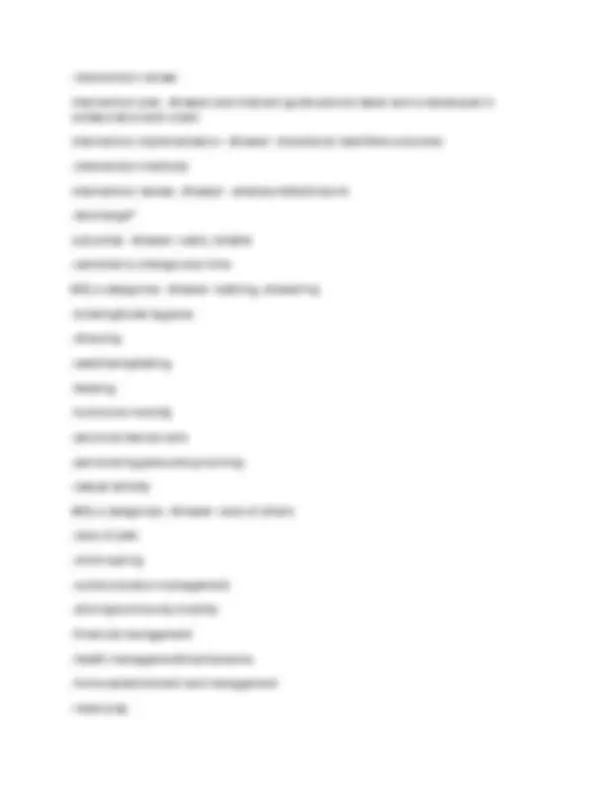
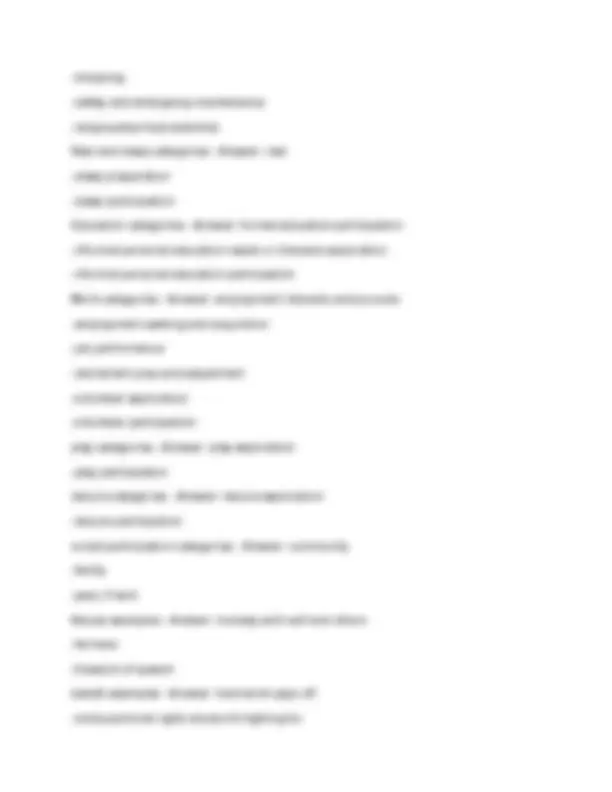
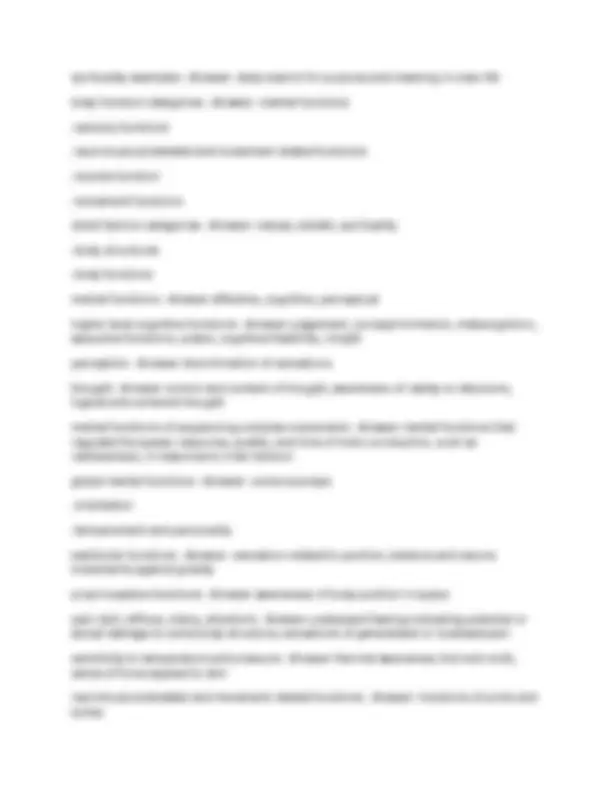
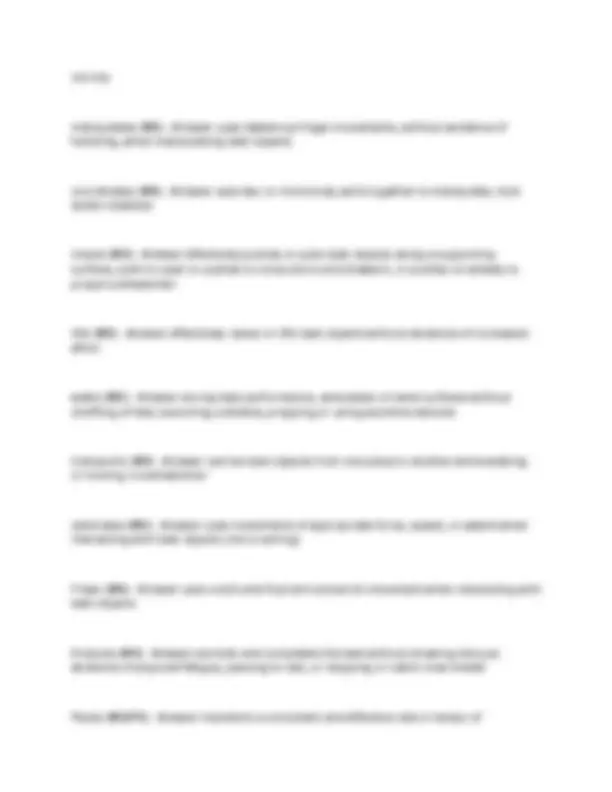
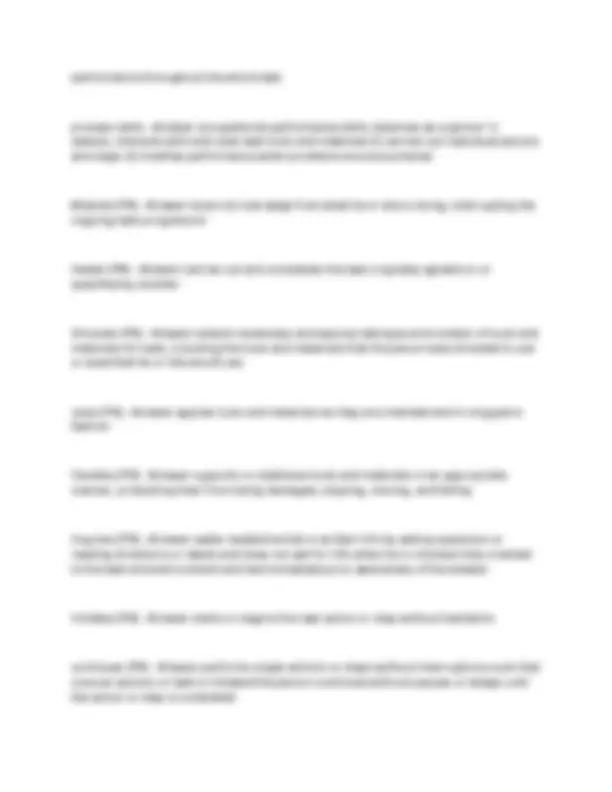
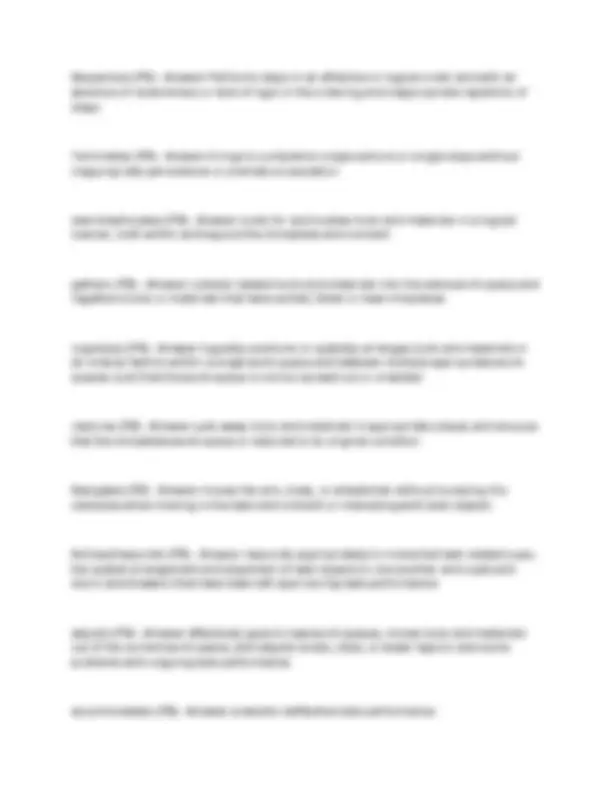
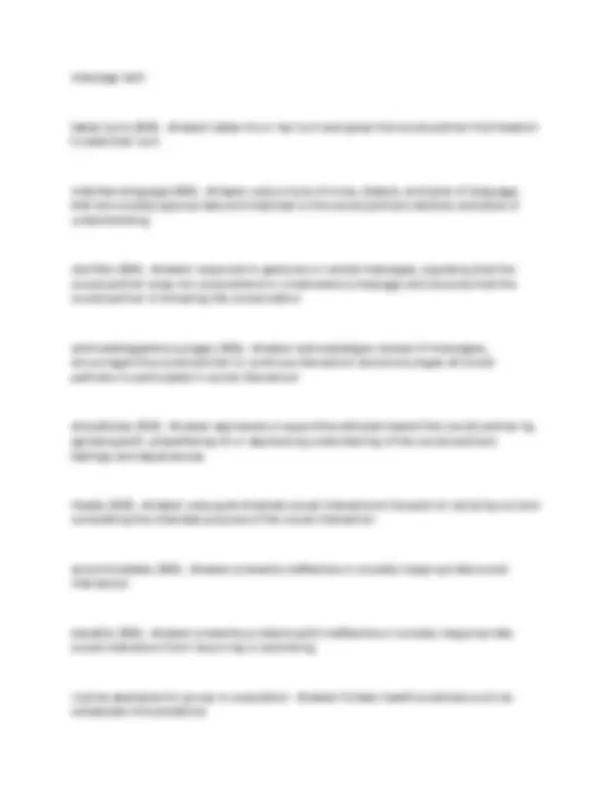
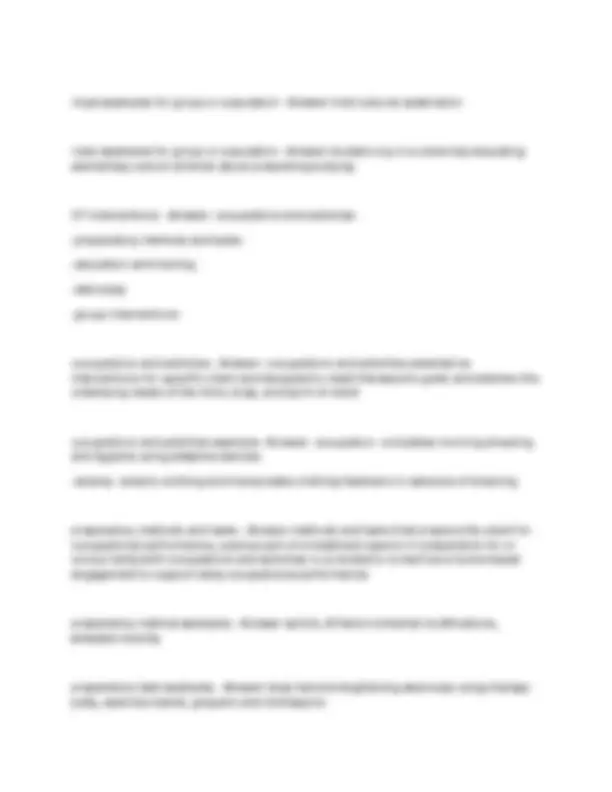
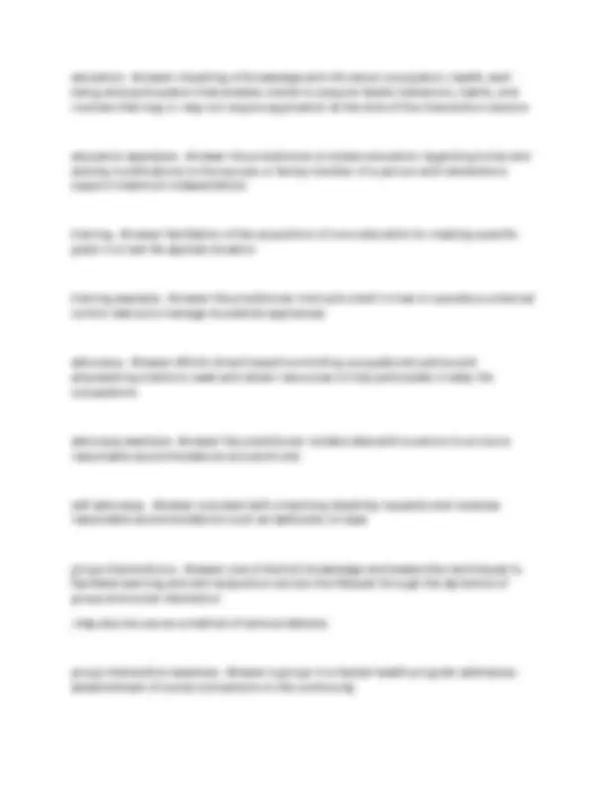


Study with the several resources on Docsity

Earn points by helping other students or get them with a premium plan


Prepare for your exams
Study with the several resources on Docsity

Earn points to download
Earn points by helping other students or get them with a premium plan
Community
Ask the community for help and clear up your study doubts
Discover the best universities in your country according to Docsity users
Free resources
Download our free guides on studying techniques, anxiety management strategies, and thesis advice from Docsity tutors
OTPF 3 EXAM STUDY GUIDE 2025-2026
Typology: Exams
1 / 17

This page cannot be seen from the preview
Don't miss anything!










5 aspects of OT's domain - Answer 1. occupations
activity, and history cultural context - Answer customs, beliefs, activity patterns, behavioral standards and expectations accepted by society of which client is a member virtual context - Answer interactions that occur in simulated, real time, or near time situations absent of physical contact physical environment - Answer natural (geographic, terrain, plants) and built (buildings, furniture) social environment - Answer the presence of, relationships with and expectations of persons, groups and populations with whom clients have contact preparatory methods - Answer -use of physical modalities -done to patient preparatory tasks - Answer -client active participation approaches to intervention - Answer -create,promote -establish, restore -maintain -modify -prevent OT process - Answer 1. evaluation
-shopping -safety and emergency maintenance -religious/spiritual activities Rest and sleep categories - Answer -rest -sleep preparation -sleep participation Education categories - Answer -formal education participation -informal personal education needs or interests exploration -informal personal education participation Work categories - Answer -employment interests and pursuits -employment seeking and acquisition -job performance -retirement prep and adjustment -volunteer exploration -volunteer participation play categories - Answer -play exploration -play participation leisure categories - Answer -leisure exploration -leisure participation social participation categories - Answer -community -family -peer, friend Values examples - Answer -honesty with self and others -fairness -freedom of speech beliefs examples - Answer -hard work pays off -some personal rights are worth fighting for
spirituality examples - Answer -daily search for purpose and meaning in ones life body function categories - Answer -mental functions -sensory functions -neuromusculoskeletal and movement related functions -muscle function -movement functions client factors categories - Answer -values, beliefs, spirituality -body structures -body functions mental functions - Answer affective, cognitive, perceptual higher level cognitive functions - Answer judgement, concept formation, metacognition, executive functions, praxis, cognitive flexibility, insight perception - Answer discrimination of sensations thought - Answer control and content of thought, awareness of reality vs delusions, logical and coherent thought mental functions of sequencing complex movements - Answer mental functions that regulate the speed, response, quality, and time of motor production, such as restlessness, in response to inner tension global mental functions - Answer -consciousness -orientation -temperament and personality vestibular functions - Answer -sensation related to position, balance and secure movements against gravity proprioceptive functions - Answer awareness of body position in space pain (dull, diffuse, sharp, phantom) - Answer unpleasant feeling indicating potential or actual damage to some body structure, sensations of generalized or localized pain sensitivity to temperature and pressure - Answer thermal awareness (hot and cold), sense of force applied to skin neuromusculoskeletal and movement related functions - Answer -functions of joints and bones
additional functions and sensations for cardiovascular and respiratory systems - Answer physical endurance, aerobic capacity, stamina, fatigability
respiratory system function - Answer rate, rhythm, and depth of respiration
cardiovascular system function - Answer maintenance of blood pressure functions (hypertension, hypotension, postural hypotension), heart rate and rhythm
skin functions - Answer protection (presence or absence of wounds, cuts or abrasions), repair (wound healing)
Motor skills - Answer occupational performance skills observed as the person interacts with and moves task objects and self around the task environment
aligns (MS) - Answer interacts with task objects without evidence or persistent propping or persistent leaning
stabilizes (MS) - Answer moves through task environment and interacts with task objects without momentary propping or loss of balance
positions (MS) - Answer positions self an effective distance from task objects and without evidence of awkward body positioning
reaches (MS) - Answer effectively extends the arm and when appropriate bends the trunk to effectively grasp or place objects that are out of reach
bends (MS) - Answer flexes or rotates the trunk as appropriate to the task to grasp or place task objects out of reach or when sitting down
grips (MS) - Answer effectively pinches or grasps task objects such that the objects do
not slip
manipulates (MS) - Answer uses dexterous finger movements, without evidence of fumbling, when manipulating task objects
coordinates (MS) - Answer uses two or more body parts together to manipulate, hold and/or stabilize
moves (MS) - Answer effectively pushes or pulls task objects along a supporting surface, pulls to open or pushes to close doors and drawers, or pushes on wheels to propel a wheelchair
lifts (MS) - Answer effectively raises or lifts task objects without evidence of increased effort
walks (MS) - Answer during task performance, ambulates on level surfaces without shuffling of feet, becoming unstable, propping or using assistive devices
transports (MS) - Answer carries task objects from one place to another while walking or moving in a wheelchair
calibrates (MS) - Answer uses movements of appropriate force, speed, or extent when interacting with task objects (not crushing)
Flows (MS) - Answer uses sooth and fluid arm and wrist movement when interacting with task objects
Endures (MS) - Answer persists and completes the task without showing obvious evidence of physical fatigue, pausing to rest, or stopping or catch ones breath
Paces (MS/PS) - Answer maintains a consistent and effective rate or tempo of
Sequences (PS) - Answer Performs steps in an effective or logical order and with an absence of randomness or lack of logic in the ordering and inappropriate repetition of steps
Terminates (PS) - Answer brings to completion single actions or single steps without inappropriate persistence or premature cessation
searches/locates (PS) - Answer looks for and locates tools and materials in a logical manner, both within and beyond the immediate environment
gathers (PS) - Answer collects related tools and materials into the same work space and regathers tools or materials that have spilled, fallen or been misplaces
organizes (PS) - Answer logically positions or spatially arranges tools and materials in an orderly fashion within a single work space and between multiple appropriate work spaces such that the work space is not too spread out or crowded
restores (PS) - Answer puts away tools and materials in appropriate places and ensures that the immediate work space is restored to its original condition
Navigates (PS) - Answer moves the arm, body, or wheelchair without bumping into obstacles when moving in the task environment or interacting with task objects
Notices/responds (PS) - Answer responds appropriately to nonverbal task related cues, the spatial arrangement and alignment of task objects to one another and cupboard doors and drawers that have been left open during task performance
adjusts (PS) - Answer effectively goes to new work spaces, moves tools and materials out of the current work space, and adjusts knobs, dials, or water taps to overcome problems with ongoing task performance
accommodates (PS) - Answer prevents ineffective task performance
benefits (PS) - Answer prevents problems with task performance from recurring or persisting
social interaction skills - Answer occupational performance skills observed during the ongoing stream of social exchange
approaches/starts (SIS) - Answer approaches or initiates interaction with the social partner in a manner that is socially appropriate
concludes/disengages (SIS) - Answer effectively terminates the conversation or social interaction, brings to closure the topic under discussion and disengages or says good-bye
produces speech (SIS) - Answer produces, spoken, signed, or augmentative messages that are audible and clearly articulated
gesticulates (SIS) - Answer uses socially appropriate gestures to communicate or support a message
speaks fluently (SIS) - Answer speaks in a fluent and continuous manner with an even pace and without pause or delays during the message being sent
turns toward (SIS) - Answer actively positions or turns the body and face toward the social partner or person who is speaking
looks (SIS) - Answer makes eye contact with the social partner
places self (SIS) - Answer positions self at an appropriate distance from the social partner during the social interaction
message sent
takes turns (SIS) - Answer takes his or her turn and gives the social partner the freedom to take their turn
matches language (SIS) - Answer uses a tone of voice, dialect, and level of language that are socially appropriate and matched to the social partners abilities and level of understanding
clarifies (SIS) - Answer responds to gestures or verbal messages, signaling that the social partner does not comprehend or understand a message and ensures that the social partner is following the conversation
acknowledges/encourages (SIS) - Answer acknowledges receipt of messages, encourages the social partner to continue interaction and encourages all social partners to participate in social interaction
empathizes (SIS) - Answer expresses a supportive attitude toward the social partner by agreeing with, empathizing ith or expressing understaning of the social partners feelings and experiences
Heeds (SIS) - Answer uses goal directed social interactions focused on carrying out and completing the intended purpose of the social interaction
accommodates (SIS) - Answer prevents ineffective or socially inappropriate social interaction
benefits (SIS) - Answer prevents problems with ineffective or socially inappropriate social interaction form recurring or persisting
routine examples for group or population - Answer follows health practices such as scheduled immunizations
ritual examples for group or population - Answer hold cultural celebration
roles examples for group or population - Answer student org in a university educating elementary school children about preventing bullying
OT interventions - Answer -occupations and activities -preparatory methods and tasks -education and training -advocacy -group interventions
occupations and activities - Answer -occupations and activities selected as interventions for specific client and designed to meet therapeutic goals and address the underlying needs of the mind, body, and spirit of client
occupations and activities example - Answer -occupation: completes morning dressing and hygiene using adaptive devices -activity: selects clothing and manipulates clothing fasteners in advance of dressing
preparatory methods and tasks - Answer methods and tasks that prepare the client for occupational performance, used as part of a treatment session in preparation for or concurrently with occupations and activities or provided to a client as a home-based engagement to support daily occupational performance
preparatory method examples - Answer splints, AT/environmental modifications, wheeled mobility
preparatory task examples - Answer does hand strengthening exercises using therapy putty, exercise bands, grippers and clothespins
activity and occupational demands - Answer the components of activities and occupations that OTs consider during the clinical reasoning process. knowledge of the demands assists OTs in selecting activities for therapeutic purposes
Relevance and importance to client (demand) - Answer alignment with the clients goals, values, beliefs and needs and perceived utility -ex: driving a car= independence
objects used and their properties (demand) - Answer tools, supplies and equipment required in the process of carrying out the activity
space demands - Answer physical environmental requirements of the activity (size, arrangement, surface, lighting, temp, noise, humidity)
social demands - Answer elements of the social environment and virtual and cultural contexts that may be required by the activity -ex: rules of the game, expectations of other participants
sequencing and timing (demands) - Answer process required to carry out the activity (specific steps, sequence of steps, timing requirements)
required actions and performance skills (demands) - Answer actions (performance skills-motor, process and social interaction) required by the client that are an inherent part of the activity -ex: gripping handle bar, answering a question
required body functions (demands) - Answer physiological functions of the body systems required to support the actions used to perform the activity ex: mobility of joint, cognitive level
required body structures (demands) - Answer anatomical parts of the body that are
required to perform the activity -ex: number of hands or feet, olfactory or taste organs
create, promote (intervention) - Answer designed to provide enriched contextual and activity experiences that will enhance performance for all people in the natural contexts of life -ex:creating a parenting class to help first-time parents engage their children in developmentally appropriate play
establish, restore (remediation, restoration-intervention) - Answer designed to change client variables to establish a skill or ability that has not yet developed or to restore a skill or ability that has been impaired -ex: collaborate with client to help establish morning routines needed to arrive at school on time
maintain (intervention) - Answer designed to provide the supports that will allow clients to preserve the performance capabilities they have regained, that continue to meet their occupational needs or both -ex: maintain safe and independent access for people with low vision by increasing hallway lighting in the home
modify (compensation, adaptation-intervention) - Answer directed at finding ways to revise the current context or activity demands to support performance in the natural setting, including compensatory techniques -ex: simplify task sequence to help a person with cognitive impairments complete a morning self-care routine
prevent (intervention) - Answer designed to address the needs of clients with or without a disability who are at risk for occupational performance problems. designed to prevent to occurrence or evolution of barriers to performance in context -ex: prevent social isolation of employees by promoting participation in after-work group activities